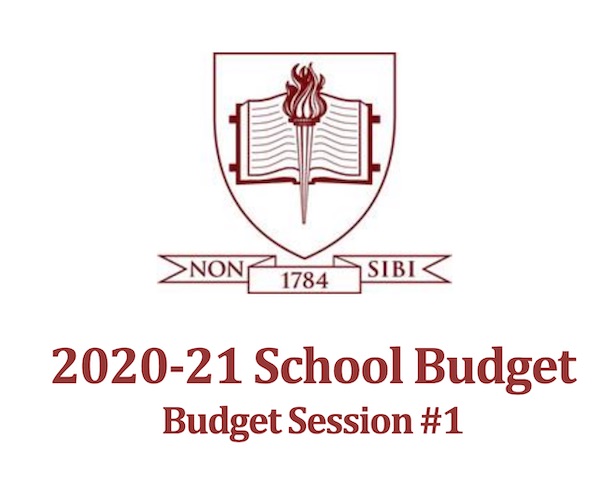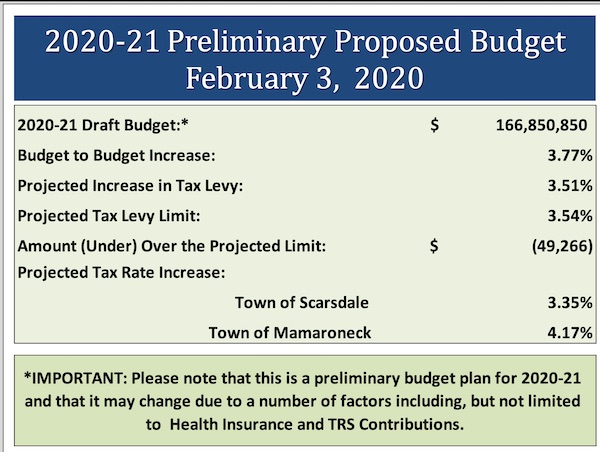Proposed 20-21 School Budget To Increase 3.77% Over 2019-20
- Wednesday, 05 February 2020 20:02
- Last Updated: Wednesday, 05 February 2020 20:07
- Published: Wednesday, 05 February 2020 20:02
- Laura Halligan
- Hits: 2507
 Last week, the school district announced that the proposed 2020-21 school budget would increase 3.86 percent over this year’s, resulting in a 3.6% percent increase to the tax levy. Since then, the administration made changes to health insurance cost projections, bringing the budget down a bit, but the plan still is a significant 3.77 percent over the current year budget, translating to a 3.51 percent tax levy increase.
Last week, the school district announced that the proposed 2020-21 school budget would increase 3.86 percent over this year’s, resulting in a 3.6% percent increase to the tax levy. Since then, the administration made changes to health insurance cost projections, bringing the budget down a bit, but the plan still is a significant 3.77 percent over the current year budget, translating to a 3.51 percent tax levy increase.
On Monday 2-5, district officials provided the first look at the nearly $167 million plan and the story behind the numbers.
Assistant Superintendent for Business Stuart Mattey began the session by reminding attendees about the district’s “guiding factors” in developing each year’s budget and offering a timeline of the process and list of public budget sessions between now and April. He then went on to speak about the district’s efforts to identify and capitalize on cost/spending efficiencies wherever possible.
“It’s always an additive process; we’re always coming back and asking for more, more, more, more. Sometimes that feels like the case but, behind the scenes, we do think of how we can do things better; how can we spend our money more efficiently; is there a different way of thinking about (something),” Mattey offered. He then pointed out a variety of the district’s budget efficiencies, including its self-funded health care plan, maximization of state aid, cooperative agreements with Scarsdale Village, purchasing practices, and technology advancements.
In looking ahead to next year’s plan, district managers asserted that the budget maintains Scarsdale’s high quality of teaching and learning and aligns with the district’s strategic plan goals. Specifically, it’s designed to:
• Ensure appropriate staffing levels;
• Enrich classroom school libraries;
• Provide materials/resources to support an “exemplary” math program, including piloting new math tools, technology, and resources to align the elementary math program with next generation standards;
• Improving global opportunities for students via travel, hosting, and virtual/online experiences;
• Provide and enhance STEAM experiences for all students;
• Create new garden models, biomechanical innovations, sustainability, and wellness projects;
• Expand the district’s ability to educate students with disabilities and those in need of specialized support; and
• Continue to upgrade building facilities consistent with the district’s master plan.
The Upshot
The draft budget currently stands at $166,850,850, which is just over $6 million more than last year’s. If adopted, Scarsdale residents would pay 3.35% more in taxes and those in the Mamaroneck Strip will pay 4.17% more. Mattey said, “It’s still a draft budget, but it’s getting closer and closer to where we need to be for the board to adopt it in April. The numbers are becoming more concrete.” He noted that the current tax levy figure is just under the projected tax levy limit of 3.54% (or $49,266).

When addressing the levy, Mattey stated, “We think 2 percent (when thinking of the limit) but rarely would it be 2 percent. The allowable tax levy, before going over the cap, is made up of not only the CPI (which currently is 1.81 percent and capped at 2 percent)… but also can be driven up by a tax-base growth factor, which is based on property assessments. We get that from the state and that number went up 10 percent… that drives the levy limit up, and then there are capital exclusions. That number in transfer to capital… also drives the (limit).” Mattey also stressed the budget still is preliminary and will change based on pending information and discussion.
Budget Drivers
The plan provides for increased spending across a number of major areas, with the largest percentage increases in plant and capital improvements, transportation (including a transportation study to review issues such as routes, staffing, GPS use, and vehicles), employee compensation and benefits, operations and maintenance, and interscholastic athletics (due to increased coaching positions/stipends, Butler Field track/sound system, and athletic training expenses), among others.
The district proposes adding 3.4 full time employees in 2020-21, two of whom will support elementary special education efforts and are based on expected enrollment. As reported earlier, district staffing has increased from 610.55 employees in 2009-10 to a planned 630.1 next year.
As always, compensation and benefit costs are the largest component of the budget by far, accounting for well over $100 million. Personnel costs throughout the district continue to rise; contractual salary increases for all employees will total $3.07 million, teacher and New York State employees retirement system mandated contributions will increase $863,000; the district’s medical insurance expense is projected to increase 4.4 percent to $762,000; and other employee benefit increases will total $524,000.
Board Member Scott Silberfein addressed the benefit increases, saying, “Obviously we don’t have a say on employee benefits for the most part… this seems to be a little bit more than in years’ past… I would be interested in exploring whether or not either a transfer from the health insurance reserve or something else may make sense to smooth out the impact on taxpayers.” Mattey noted that the 4.4 percent increase was not out of the ordinary and that it would be a danger to fund recurring costs with reserves meant to cover extraordinary events. Silberfein agreed but noted that, “We should have that discussion… I think part of the ideas of reserves is to smooth out dips and valleys and mountains for taxpayers.”
Other major budget drivers are costs related to increasing special education enrollments and plant improvements/transfers to capital fund to support high-priority infrastructure projects and facility upgrades, including the high school auditorium. The auditorium renovation, which has been deferred from previous years, has generated a fair amount of interest due to an estimated total cost of $2.3 million, most of which will be covered via a funds transfer. BOE Member Christopher Morin said, “We have to talk more about what this is, what the scope of work is, and what we get out of it. It’s a big number.” Mattey is expected to provide more information on the project during his facilities presentation planned for next week.
The district expects to recoup some costs next year, including a $225,000 reduction in the tax certiorari budget as older claims settle, a $250,000 savings in debt service due to lower interest rates on upcoming loans, and a gain of $175,000 after a reversal of prior-year non-recurring expense for security-related computer purchases.
Cooling and Security Priorities
Mattey and Assistant Superintendent of Personnel and Administrative Services Drew Patrick also reviewed specific district initiatives developed in response to resident/parent feedback that will impact facilities spending. The first of these is the installation of cooling solutions for use on excessive heat days (90 degrees or higher on the heat index). Patrick reported, “We decided to look at being able to provide workable spaces for our students on high heat days through a three-phase process.” He explained, “The first phase was to try and gain some equity across our seven buildings in having enough cooling spaces during the day… for all students to continue their learning.”
The district already has installed window air conditioning units throughout six of the buildings, and split A/C units at Heathcote. It now is working on providing at least one air conditioned, large group common space in each building, and has installed rooftop units to cool the Quaker Ridge and Fox Meadow libraries. Over the long term, the district will review both traditional and alternative options to provide additional cooled spaces with an eye towards sustainability. This year’s proposed budget provides for the installation of ceiling fans in four elementary school gymnasiums (Quaker Ridge already is equipped with fans). The district also is exploring the possibility of adding fans to multipurpose rooms sometime in the future. Ceiling fans, unfortunately, are not a viable option for the middle school and high school auditoriums due to potential problems with sports activities, such as volleyball.
Mattey then discussed the district’s efforts to enhance school safety, security, and emergency management. The district’s approach is multi-pronged, with three main components: 1) providing an external layer of safety and security at all buildings by adding visitor management and safety personnel; 2) providing additional mental health and social/emotional support for students; and 3) continuing to implement policies, practices, and procedures to promote safety and security. Prior to the start of this school year, additional safety monitors were added, directly managing visitors to each building every day, and monitoring the building site during student hours. The district also hired two new staff members: a district-wide psychologist and a high school teacher dedicated to academic pre-referral support to help identify and address potential problems. In addition, every school has a building-level safety and emergency response team that trains on a regular basis to assure consistent best practices.
The next budget discussion session is this coming Monday, February 10, at 6:30 pm, and members of the public are invited to attend and comment. For more information on specific expenses and savings, as well as supporting information, see the complete preliminary budget document, which is posted on the district’s website.